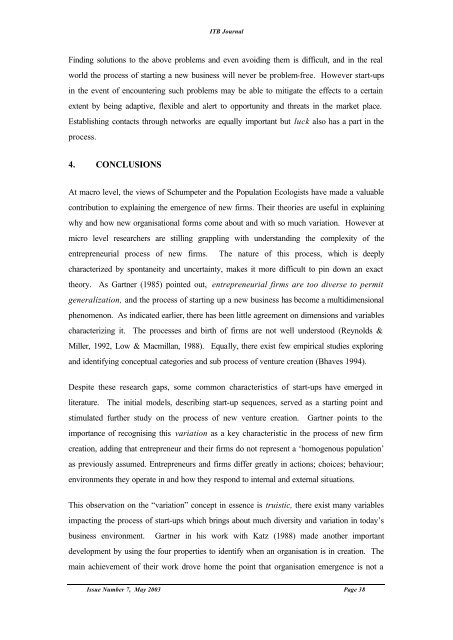ITB Journal-May-2003 - Institute of Technology Blanchardstown
ITB Journal-May-2003 - Institute of Technology Blanchardstown
ITB Journal-May-2003 - Institute of Technology Blanchardstown
Create successful ePaper yourself
Turn your PDF publications into a flip-book with our unique Google optimized e-Paper software.
<strong>ITB</strong> <strong>Journal</strong><br />
Finding solutions to the above problems and even avoiding them is difficult, and in the real<br />
world the process <strong>of</strong> starting a new business will never be problem-free. However start-ups<br />
in the event <strong>of</strong> encountering such problems may be able to mitigate the effects to a certain<br />
extent by being adaptive, flexible and alert to opportunity and threats in the market place.<br />
Establishing contacts through networks are equally important but luck also has a part in the<br />
process.<br />
4. CONCLUSIONS<br />
At macro level, the views <strong>of</strong> Schumpeter and the Population Ecologists have made a valuable<br />
contribution to explaining the emergence <strong>of</strong> new firms. Their theories are useful in explaining<br />
why and how new organisational forms come about and with so much variation. However at<br />
micro level researchers are stilling grappling with understanding the complexity <strong>of</strong> the<br />
entrepreneurial process <strong>of</strong> new firms. The nature <strong>of</strong> this process, which is deeply<br />
characterized by spontaneity and uncertainty, makes it more difficult to pin down an exact<br />
theory. As Gartner (1985) pointed out, entrepreneurial firms are too diverse to permit<br />
generalization, and the process <strong>of</strong> starting up a new business has become a multidimensional<br />
phenomenon. As indicated earlier, there has been little agreement on dimensions and variables<br />
characterizing it. The processes and birth <strong>of</strong> firms are not well understood (Reynolds &<br />
Miller, 1992, Low & Macmillan, 1988). Equally, there exist few empirical studies exploring<br />
and identifying conceptual categories and sub process <strong>of</strong> venture creation (Bhaves 1994).<br />
Despite these research gaps, some common characteristics <strong>of</strong> start-ups have emerged in<br />
literature. The initial models, describing start-up sequences, served as a starting point and<br />
stimulated further study on the process <strong>of</strong> new venture creation. Gartner points to the<br />
importance <strong>of</strong> recognising this variation as a key characteristic in the process <strong>of</strong> new firm<br />
creation, adding that entrepreneur and their firms do not represent a ‘homogenous population’<br />
as previously assumed. Entrepreneurs and firms differ greatly in actions; choices; behaviour;<br />
environments they operate in and how they respond to internal and external situations.<br />
This observation on the “variation” concept in essence is truistic, there exist many variables<br />
impacting the process <strong>of</strong> start-ups which brings about much diversity and variation in today’s<br />
business environment. Gartner in his work with Katz (1988) made another important<br />
development by using the four properties to identify when an organisation is in creation. The<br />
main achievement <strong>of</strong> their work drove home the point that organisation emergence is not a<br />
Issue Number 7, <strong>May</strong> <strong>2003</strong> Page 38
















